

Quantify Your Company’s Impact on People. Executive Summary Much attention has been paid to measuring companies’ impact on the environment.

But when it comes to impacts on people, there has been far less scrutiny, standardization, and innovation in the data used to evaluate which businesses are ‘getting it right’ than we see in the environmental field. The current state-of-the-art involves just scanning for words in corporate-issued documents. This is inadequate. Instead, we should use more solid metrics such as proportions of the workforce that are employed rather than on temporary or limited-hour contracts, ratios of CEO to median worker pay, as well as data on gender and race pay gaps.
Second-Order Effect in Product Design and Strategy. In the early 20th century, the French colonial government in Hanoi declared war on the exploding rat population by placing bounties on these little creatures.

All people had to do was to submit the tails of the rats they had killed to claim their reward. Within days, wave after wave of eager civilians submitted rat tails in droves. LinkedIn by Arianna Huffington. Eight Dimensions Worksheet. Coronavirus' business impact: Evolving perspective as of 13 May 2020. Special Report COVID-19: Facts and Insights, October 30 COVID-19: Briefing note #44, March 3, 2021 This week in McKinsey research: online learning has underwhelmed.
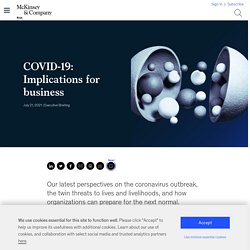
Vaccine development, however, is on pace for a surprising milestone. Although teachers around the world have different styles and standards for learning, there is one thing on which they seem to agree: a computer is no match for a classroom as a place for kids to learn. We strive to provide individuals with disabilities equal access to our website. Reopening schools depends in part on COVID-19-vaccine development, manufacturing, and distribution. That said, there’s a lot of green between the ball and the pocket: new variants of concern have emerged; not all populations have equitable access to supplies; and technology transfer at the required scale is complex and far from assured.
These challenges also worry business leaders seeking the next normal. This week, our diversity and inclusion researchers produced two new reports. Welcome to the ‘she-session.’ Why this recession is different. In 2009 Trish Hennessy and Armine Yalnizyan coined the term “he-cession” in Canada.
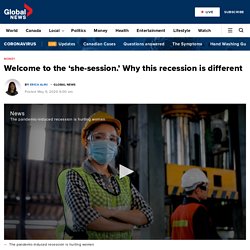
Quels sont les impacts de la Covid-19 dans notre environnement? Understand change impact across your organisation so you can manage change fatigue - New tools available. How Change Management can help manage the impacts of Covid-19 (On demand webinar) Impacts that might change the world in the coming years. A world remade Health care workers and researchers are on the front lines fighting COVID-19, hoping to slow the spread of the disease and care for the sick.
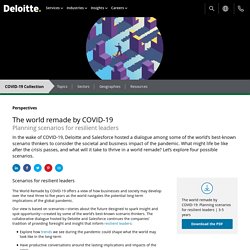
Normal life has stopped for well over a billion people around the world. While models and predictions abound, no one can say with certainty what the course of the virus will be, much less the impact the pandemic will have on people and societies. Eventually, though, the crisis will end, and life will return to “normal.” But what if it’s not like before? Managing the human and business impact of coronavirus. The global COVID-19 pandemic has forever changed our experiences―as customers, employees, citizens, humans―and our attitudes and behaviors are changing as a result.

Once the immediate threat of the virus has passed, what will have changed in the way we think and behave, and how will that affect the way we design, communicate, build and run the experiences that people need and want? The answers to these questions will be revealed in the ways people and businesses react and find innovative ways to rise above these challenging times. In consumer goods, this crisis is fundamentally changing how and what consumers buy and is accelerating immense structural changes in the industry, for example. To help accelerate response to Coronavirus-driven changes, we identified five major human implications to expect from people’s behavior now, and next.
Each has deep experience implications for all organizations. Coronavirus is crushing the economy. Here’s how to bring it back to life. The economic impact of coronavirus. The human tragedy of the COVID-19 pandemic continues to deepen, with the heaviest toll now seen in Europe and the United States.
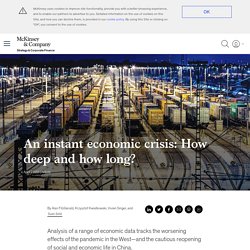
Although testing remains limited, the number of confirmed cases of the virus worldwide has exceeded 1 million, and more than 70,000 have died. The United States, Italy, and Spain have the most confirmed cases and highest death tolls. Hundreds have died in each of the past several days in Britain and France. Healthcare systems in these relatively wealthy countries are strained beyond capacities, with shortages of protective equipment for health workers and ventilators for afflicted patients contributing to infection and mortality rates. Data from China suggest that the outbreak has been largely contained there; the government is cautiously reopening economic activity but is wary of the potential for new cases. We strive to provide individuals with disabilities equal access to our website. East and West—yesterday and today Economic intervention.
How to Assess and Address Change Impacts Quickly. COVID-19 has required organizations everywhere to respond quickly to shifting conditions.
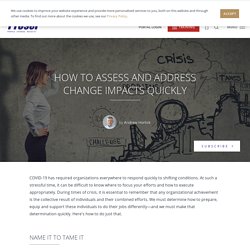
At such a stressful time, it can be difficult to know where to focus your efforts and how to execute appropriately. During times of crisis, it is essential to remember that any organizational achievement is the collective result of individuals and their combined efforts. We must determine how to prepare, equip and support these individuals to do their jobs differently—and we must make that determination quickly. Here's how to do just that. Name it to Tame It. The Impacts of Change on Business. The Power of Data: Report 1 - Understanding Change Legacy & Tracking Risks.
Accelerating the impact of from a tech-enabled transformation playbook. Technology continues to race ahead, bringing innovative applications seemingly bound only by the imagination.

Automation, the industrial Internet of Things, and robotics, among others, are transforming the way companies approach the production and delivery of goods. The coming years could bring completely automated manufacturing floors, increasingly transparent supply chains, flexible operating models—even the emergence of “dark warehouses,” which require no human workforce. Such breakthroughs are closer to reality than ever before. Consider that Tesla has claimed the production of its Model 3 is already 95 percent automated. Similarly, in late 2018, DHL launched an automated distribution center that boosted productivity by 60 percent over nonautomated facilities. Such innovations represent a tremendous opportunity. The question of why industrial companies trail their peers is a complex one. Where tech-enabled transformations flounder Phase 1: Assess Phase 2: Build and implement.
Four Invisible Dynamics You Must See to Change Your Organization. Ever wonder why your organization doesn’t change as much as you expect, despite your best efforts?

Your organization is perfectly designed to achieve the results it’s currently getting. If you want to change the results, then you have to change the way the organization achieves those results. The trouble is that the intertwining factors that cause results for an organization are often invisible. Not seeing these invisible dynamics creates two problems. Defining Change Impact (On demand webinar) Five Kinds of Impacts to Assess Before Implementing Change. When change is introduced into an organization, by definition, it will have an impact. LinkedIn by Heather Stagl and Jennifer Frahm. How to Share the Impact of Your Change Management Work. When change managers blend change management seamlessly into the fabric of key projects, our contributions can be so good they go unnoticed. People willingly adopt important changes, projects achieve intended outcomes, and leaders applaud a well-deployed initiative and its ROI. Change management, while critical, rarely shares the spotlight.
Although we strive for such happy outcomes, we can not be passive about our key contributions to these successes. Silence leads to complacency, which undermines support and resources for future efforts. Defining the Impact of Change in Agile Releases (On demand webinar) Defining Change Impact. One of the biggest challenges that change practitioners face is translating an organizational-level change – “We are implementing a new enterprise resource planning application” – to the individual level – “How the change is brought to life in the day-to-day jobs of Andre, Becky, Carlos and Dhara.” It’s a VUCA world (volatile, uncertain, complex and ambiguous). The pace and structure of our lives and the business world today is fast and continually moving. A change practitioner faced with bigger, faster and more complex change is challenged by the volume, and it becomes very easy to either forget, ignore or get lazy about managing change down to that individual level where it happens.
Bringing Change Impact Into Focus Our hope is that this frame—Prosci’s “10 Aspects of Change Impact”—is going to equip you to do that, because then you’ll start to surface those issues that we often miss and are a critical success factor in enabling change. How to Define the Impact of Change - On demand short webinar. Ten Aspects of Change Impact - On demand short webinar. Defining Change Impact - On-demand webinar.